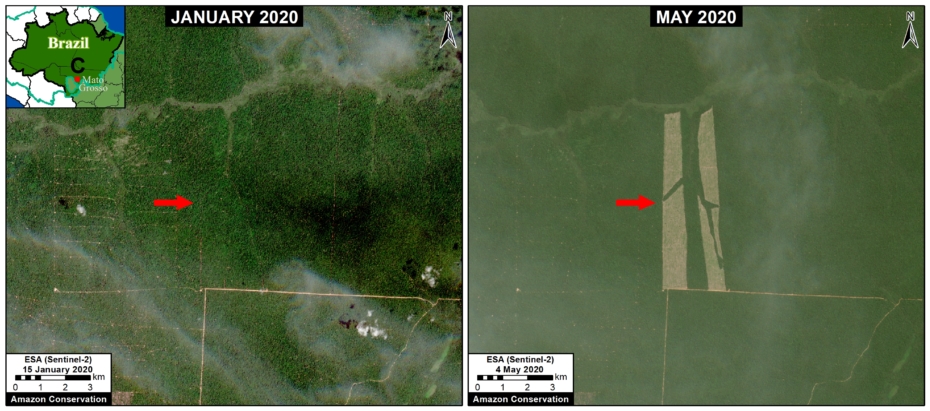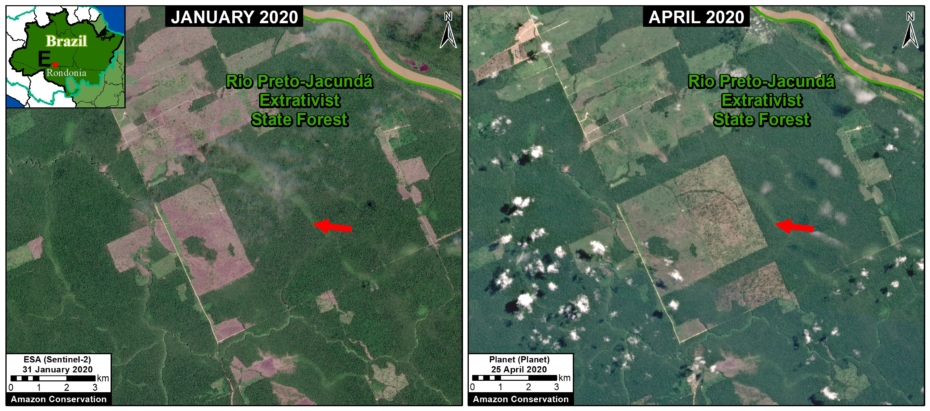
The Brazilian Amazon fires made international headlines last year.
By analyzing an archive of satellite imagery (from Planet Explorer), we made the major discovery that many of the 2019 fires were actually burning recently deforested areas (MAAP #113). In fact, many of the fires were burning areas deforested earlier that same year of 2019.
Thus, we may predict 2020 fire locations based on identifying major deforestation events in the early months of this year.
Using a novel methodology*, we estimate the deforestation of over 150,000 hectares (373,240 acres) of primary forest in the Brazilian Amazon thus far in 2020 (through May 25). Thus, there is high potential for another intense fire season.
Below, we illustrate the process of predicting 2020 fires based on recent deforestation.
Note: In MAAP #118 we just reported that the first major fires of 2020 were in fact burning recently deforested areas (2018-19).
Predicting 2020 fires
In the Base Map, the yellow dots indicate the largest new deforestation events that we predict are likely 2020 fire locations. See below for satellite imagery examples (letters A-G). Two of the likely fire points are within protected areas (see Annex).

Examples of Major 2020 Deforestation Events
Below is a series of images showing the major deforestation events of 2020 that we predict are likely upcoming fire locations (see letters A-G on the Base Map above for context). The red arrows point to the major deforestation events. Note that all of the deforestation areas are surrounded by primary forest that could be impacted if fires escape. Also note that several deforestation areas are quite large, over 2,000 hectares (5,000 acres).
Zoom A (Mato Grosso)
Zoom A shows the deforestation of 775 hectares (1,915 acres) between January (left panel) and May 2020 (right panel), in the state of Mato Grosso.
Zoom B (Mato Grosso)
Zoom B shows the deforestation of 205 hectares (510 acres) between January (left panel) and May 2020 (right panel), in the state of Mato Grosso.
Zoom C (Mato Grosso)
Zoom C shows the deforestation of 395 hectares (980 acres) between January (left panel) and May 2020 (right panel), in the state of Mato Grosso.
Zoom D (Mato Grosso)
Zoom D shows the deforestation of 300 hectares (735 acres) between January (left panel) and May 2020 (right panel), in the state of Mato Grosso.
Zoom E (Rondônia)
Zoom E shows the deforestation of 840 hectares (2,075 acres) between January (left panel) and April 2020 (right panel), in the state of Rondônia.
Zoom F (Amazonas)
Zoom F shows the deforestation of 2,395 hectares (5,920 acres) between January (left panel) and May 2020 (right panel), in the state of Amazonas.
Zoom G (Pará)
Zoom G shows the deforestation of 5,990 hectares (14,800 acres) between January (left panel) and May 2020 (right panel), in the state of Pará.
Coordinates
World Eckert IV (Decimal Degrees) (X,Y)
Zoom A: -54.862624, -11.971904
Zoom B: -55.087026, -11.836788
Zoom C: -56.999405, -11.979054
Zoom D: -57.128192, -11.896948
Zoom E: -62.658907, -8.477944
Zoom F: -58.892358, -6.567775
Zoom G: -54.948419, -7.853721
2020 Fire Forecast
The July – September 2020 forecast points to an active fire season in most of the western Amazon – much of central and southern Peru, northern Bolivia and the Brazilian states of Acre and Rondônia. This year’s forecast indicates an active fire season of similar magnitude to those of 2005 and 2010, when widespread fires were observed in the region.
To more information check:https://firecast.cast.uark.edu/
Annex – Likely 2020 fire locations in relation to Protected Areas and Indigenous Territories
Methodology
*We developed a novel methodology to estimate deforestation of primary forest in the Brazilian Amazon. For 2020 data, we merged confirmed GLAD alerts (University of Maryland) with select DETER alerts from the Brazilian space agency (INPE). This methodology takes advantage of the higher resolution of the GLAD alerts (30 meters vs 64 meters from DETER), but also the national expertise of the Brazilian government.
For the DETER data, we used the three deforestation and mining categories (DESMATAMENTO CR, DESMATAMENTO Vegetal, and MINERACAO). We avoided overlapping areas with the GLAD alerts.
Finally, we filtered the data for only primary forest loss. For our estimate of primary forest loss, we intersected the forest cover loss data with the additional dataset “primary humid tropical forests” as of 2001 (Turubanova et al 2018). We also removed all previous forest loss data 2001-19.
Acknowledgements
We thank J. Beavers, S. Novoa, K. Fernandes, and G. Palacios for helpful comments to earlier versions of this report.
This work was supported by the following major funders: Global Forest Watch Small Grants Fund (WRI), Norwegian Agency for Development Cooperation (NORAD), International Conservation Fund of Canada (ICFC), Metabolic Studio, and Erol Foundation.
Citation
Finer M, Mamani N (2020) Deforestation and Fires in the Brazilian Amazon – 2020. MAAP:




























